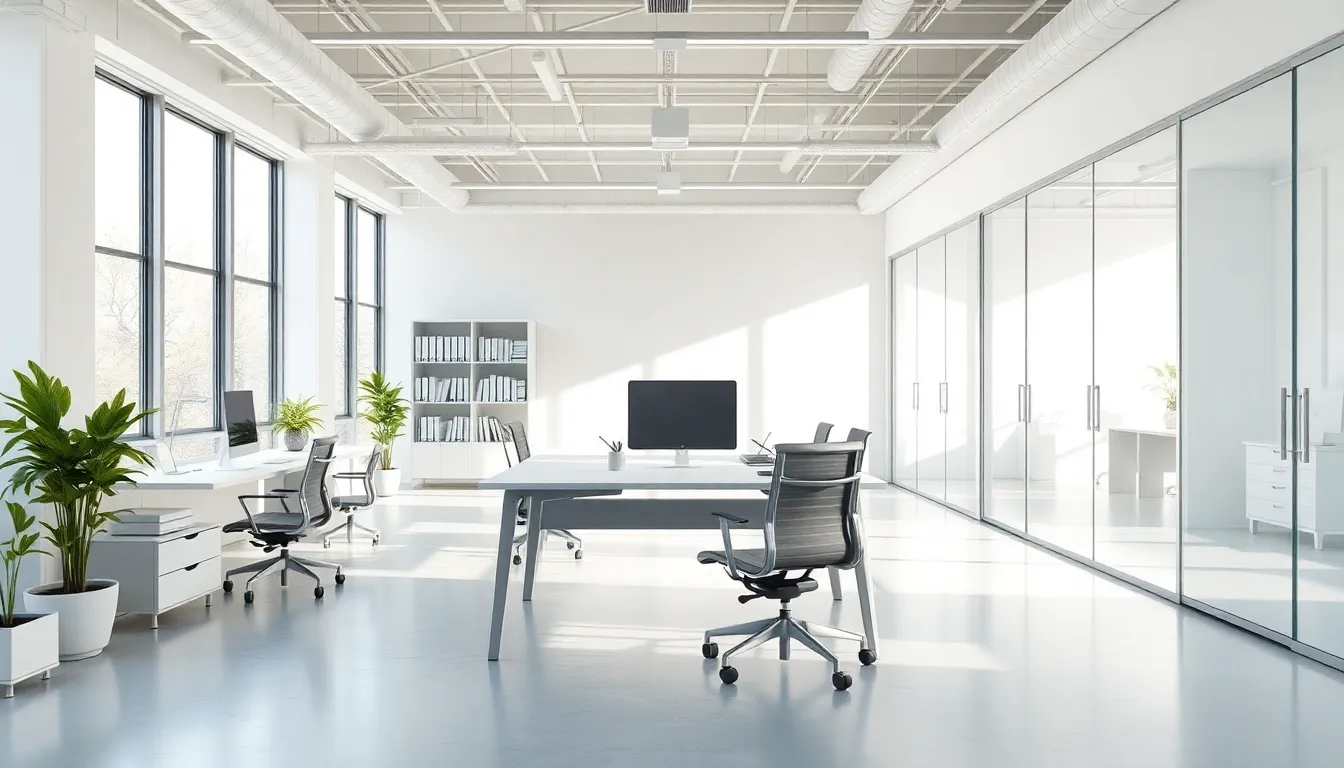In today’s fast-paced world, minimal office design is gaining traction as a go-to solution for creating productive workspaces. By stripping away unnecessary clutter and focusing on essential elements, companies are discovering that less truly can be more. This design philosophy not only enhances aesthetics but also promotes a sense of calm and clarity among employees.
Embracing minimalism in the office allows for better organization and improved functionality. With clean lines and a thoughtfully curated selection of furnishings, businesses can foster an environment that encourages creativity and collaboration. As the demand for flexible and efficient workspaces rises, minimal office design stands out as an innovative approach to meet the needs of modern professionals.
Table of Contents
ToggleWhat Is Minimal Office Design?
Minimal office design emphasizes simplicity, functionality, and decluttered spaces. This approach prioritizes essential elements, eliminating excess items that distract from work. By using a restrained color palette and clean lines, minimal office design creates an inviting atmosphere, encouraging focus and productivity.
Key features of minimal office design include:
- Open Spaces: An unobstructed layout allows easy movement and interaction.
- Natural Light: Windows and daylight maximize energy and motivation.
- Functional Furniture: Multi-purpose and simple furniture maximizes usability without sacrificing aesthetics.
- Limited Decoration: Artwork and accessories, if present, maintain the minimalistic theme and serve a purpose.
Minimal office design fosters a calm environment, promoting creativity and collaboration among employees. It addresses the need for flexibility in workspaces, responding to the evolving demands of modern professionals.
Key Principles of Minimal Office Design

Minimal office design emphasizes the importance of simplicity and functionality, reducing distractions while promoting a calming environment conducive to productivity. Key principles establish a solid foundation for this approach.
Simplicity and Functionality
Simplicity in office design involves using fewer items, focusing on essential elements that enhance usability. Functional furniture includes multi-purpose desks and ergonomic chairs, providing comfort while maximizing space. Open shelving may replace bulky filing cabinets, keeping materials accessible without creating clutter. Prioritizing versatile layouts allows for easy adaptation to changing work requirements, reinforcing the minimalist ethos.
Open Space Concept
The open space concept fosters collaboration and communication among team members. Unobstructed areas facilitate movement and interaction, reducing barriers in the workplace. Flexible seating arrangements invite teamwork and brainstorming sessions, while designated zones for focused work balance collaboration with individual productivity. Incorporating partitions made of glass or light materials can create privacy without sacrificing openness, optimizing the workspace.
Neutral Color Palettes
Neutral color palettes are integral to minimal office design, promoting a serene atmosphere. Shades such as whites, grays, and beiges create a calming backdrop while allowing the beauty of natural light to shine through. Accent colors can be strategically introduced through furniture or decor, maintaining the minimalist aesthetic. A cohesive color scheme also contributes to a sense of harmony within the office, enhancing overall focus and creativity.
Benefits of Minimal Office Design
Minimal office design offers various advantages that enhance overall workplace efficiency and satisfaction. This approach streamlines the work environment, optimizing functionality while promoting a calming atmosphere.
Enhanced Productivity
Enhanced productivity stems from decreased distractions and increased focus. Minimal office design prioritizes essential elements, helping employees concentrate on their tasks with reduced visual clutter. Open layouts facilitate collaboration, allowing for easier communication among team members. Natural light, emphasized in minimal designs, boosts energy levels and motivation, leading to higher performance. Studies indicate that environments with ample natural light can improve productivity by up to 15%.
Improved Aesthetics
Improved aesthetics contribute to a more inviting workspace. Minimal office design utilizes neutral color palettes and clean lines, creating visually appealing environments that enhance employee well-being. Limited decoration allows for a sense of openness and tranquility. Well-thought-out furniture choices foster both functionality and style, making the office space feel organized and purposeful. Aesthetic improvements not only uplift employee morale but also impress clients, reflecting a professional image.
Tips for Implementing Minimal Office Design
Implementing minimal office design enhances productivity and creates a serene work environment. Focus on incorporating essential elements that promote functionality and reduce clutter.
Selecting the Right Furniture
- Choose functional furniture that serves multiple purposes. Consider desks with built-in storage or modular seating arrangements that facilitate flexibility.
- Prioritize ergonomic designs that support employee well-being. Chairs with adjustable features improve comfort and encourage good posture.
- Opt for simple styles that complement a minimalist aesthetic. Select pieces with clean lines and neutral colors to maintain a cohesive look.
- Integrate multi-functional items such as folding tables or stackable chairs. These items aid in maximizing space and adapting to various needs.
Organizational Strategies
- Implement storage solutions that maintain a clutter-free environment. Use concealed storage options like cabinets or drawers to keep items out of sight.
- Utilize vertical space for organization. Install shelves or wall-mounted units to store materials while saving floor space.
- Encourage employees to personalize their work areas minimally. Limit decorations to a select few meaningful items that enhance individuality without overwhelming the space.
- Regularly assess and declutter workspaces. Foster a culture of maintaining a tidy environment by scheduling periodic cleans and encouraging employees to dispose of unnecessary items.
Minimal office design is more than just a trend; it’s a strategic approach to creating effective workspaces. By prioritizing simplicity and functionality, organizations can foster environments that enhance productivity and employee satisfaction. The focus on decluttered spaces and multi-purpose furniture not only promotes collaboration but also allows for greater creativity.
As workplaces continue to evolve, adopting minimal design principles can lead to significant benefits, including improved morale and a professional image. Embracing this design philosophy can transform how teams work together, making it an essential consideration for modern businesses looking to thrive in a competitive landscape.



